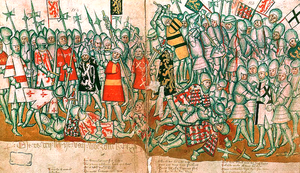War of the Limburg Succession
| War of the Limburg Succession | |||||||
|---|---|---|---|---|---|---|---|
 15th century depiction of the Battle of Worringen from a manuscript of Brabantsche Yeesten (Royal Library of Belgium) | |||||||
| |||||||
| Belligerents | |||||||
|
County of Nassau |
County of Waldeck | ||||||
| Commanders and leaders | |||||||
|
Adolf of Nassau |
Otto I of Waldeck | ||||||
The War of the Limburg Succession was a conflict between 1283 and 1289 for the succession in the Duchy of Limburg.
The cause of the War of the Limburg Succession was the death of Waleran IV, Duke of Limburg in 1280, and his only daughter Ermengarde of Limburg in 1283. Waleran IV had no sons and Ermengarde had no children. Ermergarde had married Reginald I of Guelders, who now claimed the Duchy of Limburg. However, Waleran's nephew Adolf VIII of Berg, son of his elder brother Adolf VII of Berg, also claimed the Duchy. Unable to assert his claims, he sold them in 1283 to the mighty John I, Duke of Brabant.
Between 1283 and 1288, several smaller confrontations occurred between both sides, none of them decisive. Meanwhile, most of the other local powers chose sides.
After the decisive Battle of Worringen in 1288, won by Duke John I of Brabant and his allies, the Duchy of Limburg came in the possession of the Duke of Brabant. The City of Cologne gained its independence from the Archbishopric and finally the status of an Imperial city in 1475.
